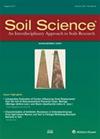长期矿肥施肥对水稻红壤磷素积累和溶磷微生物的影响
4区 农林科学
Q2 Agricultural and Biological Sciences
引用次数: 4
摘要
摘要了解不同施肥管理下土壤磷的转化和周转对评价土壤磷的可持续肥力和潜在生物有效性具有重要意义。因此,在水稻红壤上进行了长期施肥试验(~ 38年),施用不同的无机和有机肥料,以确定不同肥料用量对池积累和微生物群落的影响,特别是对磷肥溶解微生物(psm)的影响。长期无机磷(IP)施肥增加了总磷(TP) (~ 479 mg kg - 1)、速效磷(~ 417 mg kg - 1)和无机磷(~ 18 mg kg - 1)的浓度,但施肥加速了有机磷的积累,特别是正磷酸盐单酯(例如,myo-IHP, ~ 12 mg kg - 1)。长期矿物施肥降低了细菌丰富度、均匀度和细菌网络的复杂性。相反,长期施肥和根际积累了更多的总碳、总氮和有机碳,并调节了土壤ph,从而促进了细菌群落的分离。此外,PSM组成受施肥管理和根际影响较大。例如,无机磷肥增加了硫杆菌(即本研究中最丰富的磷酸盐溶解菌)的丰度,并改变了PSB的群落结构。相应的,无机磷和全磷浓度是影响PSB群落结构变化的关键因素。这些发现有助于了解长期无机和/或有机施肥条件下psm土壤无机和有机磷库及微生物群落的变化。本文章由计算机程序翻译,如有差异,请以英文原文为准。
The role of long-term mineral and manure fertilization on P species accumulation and phosphate-solubilizing microorganisms in paddy red soils
Abstract. Understanding soil phosphorus (P) transformation and turnover under various fertilization managements is important for evaluating sustainable P fertility and potential bioavailability in agriculture managements. Thus, long-term fertilization experiments (∼ 38 years) with the application of different inorganic and organic fertilizers in paddy red soils were
conducted to determine the effect of different fertilizer applications on P
pool accumulation and microbial communities, especially for phosphate-solubilizing microorganisms (PSMs). Long-term inorganic P (IP) fertilization increased the concentrations of total P (TP) (∼ 479 mg kg−1), available P (AP) (∼ 417 mg kg−1) and
inorganic P (∼ 18 mg kg−1), but manure
fertilization accelerated the accumulation of organic P, especially for
orthophosphate monoesters (e.g., myo-IHP, ∼ 12 mg kg−1). Long-term mineral fertilization decreased bacterial richness,
evenness and complexation of bacterial networks. In contrast, long-term
manure fertilization and rhizosphere accumulated more amounts of total
carbon, total nitrogen, and organic carbon, as well as regulated the soil
pH, thus improving the separation of bacterial communities. Furthermore, PSM compositions were greatly influenced by fertilization managements and
rhizosphere. For example, inorganic P fertilization increased the abundance
of Thiobacillus (i.e., the most abundant phosphate-solubilizing bacteria (PSB) in this study) and shifted the community structure of PSB. Correspondingly, the concentrations of inorganic and total P were the key factors for the variation of the PSB community structure. These findings are beneficial for understanding the variation of inorganic and organic P pools and the microbial community, especially for PSMs under long-term inorganic and/or organic fertilization.
求助全文
通过发布文献求助,成功后即可免费获取论文全文。
去求助
来源期刊

Soil Science
农林科学-土壤科学
CiteScore
2.70
自引率
0.00%
发文量
0
审稿时长
4.4 months
期刊介绍:
Cessation.Soil Science satisfies the professional needs of all scientists and laboratory personnel involved in soil and plant research by publishing primary research reports and critical reviews of basic and applied soil science, especially as it relates to soil and plant studies and general environmental soil science.
Each month, Soil Science presents authoritative research articles from an impressive array of discipline: soil chemistry and biochemistry, physics, fertility and nutrition, soil genesis and morphology, soil microbiology and mineralogy. Of immediate relevance to soil scientists-both industrial and academic-this unique publication also has long-range value for agronomists and environmental scientists.
 求助内容:
求助内容: 应助结果提醒方式:
应助结果提醒方式:


